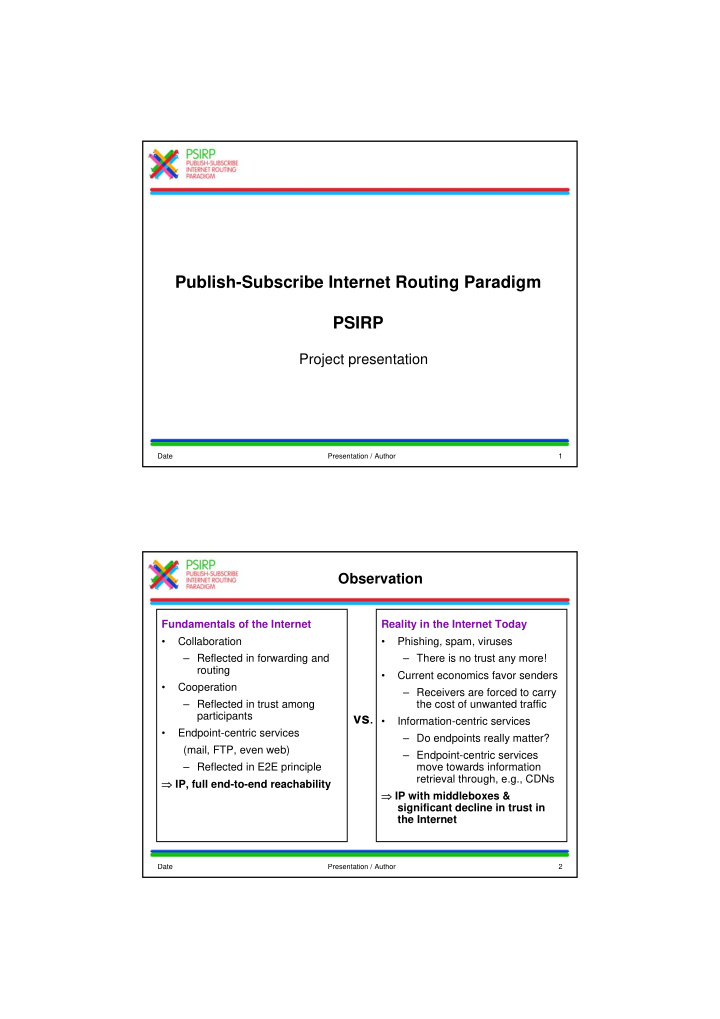



Publish-Subscribe Internet Routing Paradigm PSIRP Project presentation Date Presentation / Author 1 Observation Fundamentals of the Internet Reality in the Internet Today • Collaboration • Phishing, spam, viruses – Reflected in forwarding and – There is no trust any more! routing • Current economics favor senders • Cooperation – Receivers are forced to carry – Reflected in trust among the cost of unwanted traffic participants vs . • Information-centric services • Endpoint-centric services – Do endpoints really matter? (mail, FTP, even web) – Endpoint-centric services – Reflected in E2E principle move towards information retrieval through, e.g., CDNs ⇒ IP, full end-to-end reachability ⇒ IP with middleboxes & significant decline in trust in the Internet Date Presentation / Author 2
Hypothesis: Clean-Slate Design Required Clean-slate design… • Question ALL fundamentals • Challenge our thinking • What stood at the beginning • Take nothing for granted, including – Collaboration industry structures – Cooperation • Clear vision – Endpoint-centric services does not seem enough …with late binding (to reality) • Consider migration and evolvability • What about: in separate work items – Trust? – How to get our design into real – Information centrism? deployments, e.g., overlay vs. IP replacement? – Legitimacy of E2E? • Even consider necessary evolution – Role of overlays? of industry (& regulatory) structures – How do industries need to evolve in certain scenarios? Date Presentation / Author 3 Vision Envision a system that dynamically adapts to evolving concerns and needs of their participating users • Publish-subscribe communication paradigm promises to address many of the problems we are facing today – e.g., publish–subscribe restores the balance of network economics incentives between the sender and the receiver • Recursive use of publish- subscribe paradigm enables dynamic change of roles between actors Date Presentation / Author 4
Main PSIRP design principles • Information is multi-hierarchically organised – Higher-level information semantics are constructed in Information the form of directed acyclic graphs (DAGs), starting reachability/ with meaningless forwarding labels towards higher scoping Information level concepts (e.g., ontologies). Hierarchies • Information scoping – Mechanisms are provided that allow for limiting the reachability of information to the parties having access to the particular mechanism that implements the scoping. • Scoped information neutrality – Within each scope of information, data is only forwarded based on the given (scoped) identifier. Communication Model • The architecture is receiver-driven – No entity shall be delivered data unless it has agreed to receive those beforehand, through appropriate signalling methods. Date Presentation / Author 5 Potential Impact of our Work User Industry • Relevant Information at your fingertips • Relevant Information at your fingertips • Entry of new players, e.g., information • Entry of new players, e.g., information • Pubsub allows for explicit expression • Pubsub allows for explicit expression brokers & bankers, information of intention brokers & bankers, information of intention processing providers -> address attention scarcity processing providers -> address attention scarcity • Content providers likely to become • Wherever, from whoever, through • Content providers likely to become • Wherever, from whoever, through whatever access, on whatever device more powerful whatever access, on whatever device more powerful • Emulates sensing, processing, • New technology means potential for • Emulates sensing, processing, • New technology means potential for actuation new business actuation new business -> More natural form of communication • Increase in (information-centric) -> More natural form of communication • Increase in (information-centric) • Ability to avoid information overload communication needs will increase • Ability to avoid information overload communication needs will increase • Tackle attention scarcity problem need in solutions • Tackle attention scarcity problem need in solutions • Increased security & privacy • Increased security & privacy • Enable cross-value chain scenarios • Enable cross-value chain scenarios • Only relevant information gathered & • Only relevant information gathered & • retail, health, finance, … • retail, health, finance, … provided to user provided to user Date Presentation / Author 6
Project Objectives • Specify, implement and test an internetworked pubsub architecture – follow clean-slate design approach • Perform qualitative and quantitative evaluation – Security and socio-economics important! – Migration and incentive scenarios important (e.g., overlay)! • The results will be widely published – Open source code for the Future Internet – Targets specifically SMEs opportunities in Future Internet • Engage with FI community – Cooperate with FIRE (Onelab2) to test on large scale – Engage openly through public Wikis Date Presentation / Author 7 Project Overview Project Coordinator WP1 Management (TKK-HIIT) Arto Karila Helsinki University of Technology, HIIT Tel: +358 50 384 1549 WP2 Architecture Design Fax: +358 9 694 9768 (TKK-HIIT) Email:arto.karila@hiit.fi Partners : WP3 Implementation, • Helsinki University of Technology Helsinki Institute for Information Technology (FI) Prototyping & Testing (LMF) • RWTH Aachen University (DE) • British Telecommunications Plc (GB) • Oy L M Ericsson Ab (FI) WP4 Validation and Tools • Nokia Siemens Networks Oy (FI) (BT) • Institute for Parallel Processing of the Bulgarian Academy of Science (BG) • Athens University of Economics and Business (GR) WP5 Dissemination and • Ericsson Magyarorszag Kommunikacios Rendszerek K.F.T. (HU) Exploitation (NSNF) Duration: January 2008 – June 2010 Total Cost: €4.1m Project website: www.psirp.org EC Contribution: €2.5m Contract Number: INFSO-ICT-216173 Date Presentation / Author 8
Recommend
More recommend